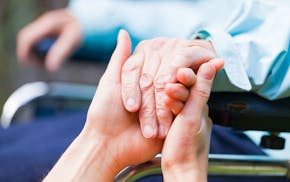Opinion editor's note: Strib Voices publishes a mix of guest commentaries online and in print each day. To contribute, click here.
•••
The recent Guardian investigation (tinyurl.com/guardian-uhg) and Minnesota Star Tribune coverage of UnitedHealth Group's nursing home program raise important public questions. But lost in the noise is a clear understanding of what these programs are designed to do: improve care for frail older adults by avoiding the serious harm that can result from unnecessary hospitalizations.
We write as a nurse practitioner, nurse and geriatrician who helped develop and lead the Evercare program — UnitedHealth Group's original name for its care model for long-stay nursing home residents — from 1988 through 2009. We are not speaking for the company today, nor can we comment on how its current programs operate. But we do want to offer a perspective grounded in decades of hands-on care and extensive clinical research.
First, it is well known in geriatric medicine that hospitalization can be profoundly disruptive and even dangerous for older adults. They are highly susceptible to hospital-acquired infections, medication errors, delirium, sleep disturbances and loss of function. Many never recover from these setbacks. Transitions back to home or to post-acute care are fraught with additional risks — fragmented communication, unmet needs and overwhelmed family caregivers. Re-hospitalization rates remain alarmingly high, further compounding these harms.
Second, many of these hospitalizations are preventable. A well-established measurement framework, known as Ambulatory Care Sensitive Conditions (ACSC), has been used by the federal government and others to identify hospital admissions that typically can be avoided with timely, high-quality outpatient care. The data consistently show that older adults, especially those with chronic illness or dementia, often end up in hospitals when the right care could have been delivered where they live.
Third, several clinical models in the U.S. have been shown to safely reduce these avoidable hospitalizations — hospital-at-home programs, home-based primary care, transitional care initiatives and, importantly, nursing-home-based care through Institutional Special Needs Plans (I-SNPs). These models, including the one criticized in the Guardian, are built on evidence. Repeated evaluations have demonstrated improved patient outcomes, greater satisfaction, reduced caregiver burden, lower costs and, in many cases, lower mortality.
Evercare was the forerunner of these models. Created in Minnesota by two nurse practitioners and a geriatrician, Evercare began as a Medicare demonstration in the 1990s and was studied in six states. It showed reduced hospital use and mortality, high family satisfaction and care quality comparable to or better than traditional approaches. Our clinical model centered on understanding what matters to the patient, proactive and holistic care planning, early recognition of emerging illness and close coordination with nursing facility staff and families.
This kind of high-touch, person-centered care takes time — time that isn't reimbursed in fee-for-service Medicare. It requires a different payment approach. Value-based care, in which providers are paid prospectively and rewarded for quality and outcomes rather than volume, enables these improvements. That's why the Centers for Medicare & Medicaid Services (CMS) aims to have all Medicare beneficiaries cared for under value-based models by 2030.
Under value-based models, providers across the continuum — including nursing homes — can share in savings, but only if they meet specific quality measures. It is not simply about spending less — it's about doing better. More care is delivered on-site in the nursing home, which raises provider costs and requires adequate funding.
Evercare's malpractice record speaks volumes about the quality and safety of its care. Across more than a decade, the program's rate of malpractice claims was one one-hundredth of the national average in nursing homes.
We fully support transparency and accountability. But we also caution against drawing sweeping conclusions from anecdotal reporting that fails to consider the well-documented risks of hospitalization and the extensive literature supporting models of in-place care.
Minnesota helped lead the way with the development of Evercare. We should be proud of that legacy and continue to build on it, not abandon it. The future of elder care lies not in reactionary hospitalizations, but in thoughtful, proactive care that meets older people where they are — with dignity, clinical excellence and respect for their values.
John Mach is a board-certified geriatrician and was the chief medical officer of Evercare from 1996 to 2009 and CEO of Evercare from 2002 to 2009. Pat Kappas-Larson and Nancy Williams were senior nurse leaders at Evercare. This commentary was submitted in advance of, and not in connection with, developments in which UnitedHealth Group is suing the Guardian and alleging defamation for its investigation and report.

Rash: At home, Jake Sullivan reflects on events abroad

Opinion: Let's not lose sight of what's best for older adults

Readers Write: Minneapolis politics, Trump's budget, hot tub rentals

